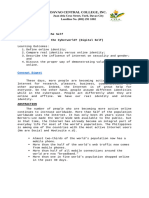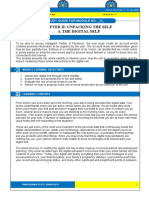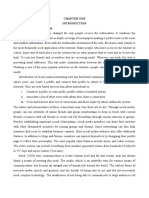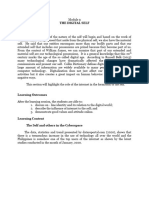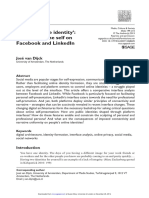Lesson 8
Lesson 8
Uploaded by
katelyn moralesCopyright:
Available Formats
Lesson 8
Lesson 8
Uploaded by
katelyn moralesCopyright
Available Formats
Share this document
Did you find this document useful?
Is this content inappropriate?
Copyright:
Available Formats
Lesson 8
Lesson 8
Uploaded by
katelyn moralesCopyright:
Available Formats
Reference No: KLL-FO-ACAD-000 | Effectivity Date: August 3, 2020 | Revisions No.
: 00
VISION MISSION
A center of human development committed to the pursuit of wisdom, truth, Establish and maintain an academic environment promoting the pursuit of
justice, pride, dignity, and local/global competitiveness via a quality but excellence and the total development of its students as human beings,
affordable education for all qualified clients. with fear of God and love of country and fellowmen.
GOALS
Kolehiyo ng Lungsod ng Lipa aims to:
1. foster the spiritual, intellectual, social, moral, and creative life of its client via affordable but quality tertiary education;
2. provide the clients with reach and substantial, relevant, wide range of academic disciplines, expose them to varied curricular and co-curricular
experiences which nurture and enhance their personal dedications and commitments to social, moral, cultural, and economic transformations.
3. work with the government and the community and the pursuit of achieving national developmental goals; and
4. develop deserving and qualified clients with different skills of life existence and prepare them for local and global competitiveness
MODULE 8
FIRST Semester, AY 2021-2022
I. COURSE CODE/TITLE: GE101 – UNDERSTANDING THE SELF
II. SUBJECT MATTER:
LESSON 8 Time –Frame
Who Am I in the Cyberworld? (Digital Self)
III. COURSE OUTCOMES
At the end of the course, the students should be able to:
1. define online identity;
2. compare real identity versus online identity;
3. describe the influence of Internet on sexuality and gender; and
4. discuss the proper way of demonstrating values and attitudes online.
IV. ENGAGEMENT
INTRODUCTION
These days, more people are becoming active in using the Internet for research, pleasure,
business, communication, and other purposes. Indeed, the Internet is of great help for everyone.
On the other hand, people assume different identities while in the cyberspace. People act
differently when they are online and offline. We have our real identity and online identity.
What have you learned from the activity? Did you learn something from your classmates
that you did not know before? What were the clues that helped you figure out which statements
were facts and fiction? Were your classmates able to discern easily the facts and fiction about
you? Why?
Applying the same activity in the virtual world or cyberworld, how do people portray
themselves online? What are the things that you would want to post/share online? What are the
things you want others to share online?
ABSTRACTION
The number of people who are becoming more active online continues to increase
worldwide. More than half of the population worldwide now uses the Internet. It has only been 25
years since Tim Berners-Lee made the World Wide Web available to the public, but in that time,
the Internet has already become an integral part of everyday life for most of the world's
population. The Philippines is among one of the countries with the most active Internet users (We
are Social and Hootsuite n.d.).
Almost two-thirds of the world's population now has a mobile phone.
Marawoy, Lipa City, Batangas 4217 | https://www.facebook.com/KLLOfficial/
More than half of the world's web traffic now comes from mobile phones.
More than half of all mobile connections around the world are now "broadband."
More than one in five of the world's population shopped online in the past 30 days.
Media users in the Philippines grew by 12 million or 25% while the number Of mobile social
users increased by 13 million or 32%. Those growth figures are still higher compared to the
previous year. More than half the world now uses a smartphone.
Based on Figure 1, the number of digital users worldwide increases. More people are
becoming interested and devoted in using the Internet for various activities. In the Philippines,
adolescents are among the most avid users of the Internet.
Marawoy, Lipa City, Batangas 4217 | https://www.facebook.com/KLLOfficial/
Online identity is actually the sum of all our characteristics and our interactions while partial
identity is a subset of characteristics that make up our identity. Meanwhile, persona is the partial
identity we create that represents ourselves in a specific situation.
Selective Self-presentation and Impression Management
According to Goffman (1959) and Leary (1995), self-presentation is the "process of
controlling how one is perceived by other people" and is the key to relationship inception and
development. To construct positive images, individuals selectively provide information about
them and carefully cater this information in response to other's feedback.
Anything posted online should be considered "public" no matter what our "privacy" settings
are. Let us say, a student wrote online about how much he hated another student in school, and
started bullying him online. Does it matter if the student said, "Well, this is my personal account"?
Even if the student wrote it in a "private" account, it can become public with a quick screen
capture and shared with the world. Personal identity is the interpersonal level of self which
differentiates the individual as unique from others, while social identity is the level of self whereby
the individual is identified by his or her group memberships.
Belk (2013) explained that sharing ourselves is no longer new and has been practiced as
soon as human beings were formed. Digital devices help us share information broadly, more than
ever before. For those who are avid users of Facebook, it is possible that their social media
friends are more updated about their daily activities, connections, and thoughts than their
immediate families. Diaries that were once private or shared only with close friends are now
posted as blogs which can be viewed by anyone. In websites like .Flickr or Photobucket, the use
of arm's-length self-photography indicates a major change. •In older family albums, the
photographer was not often represented in the album (Mendelson and Papacharissi 2011),
whereas with arm's-length photos, they are necessarily included (e.g., selfies and groupies). In
addition, the family album of an earlier era has become more of an individual photo gallery in the
digital age. As Schwarz (2010) mentioned, we have entered an extraordinary era of self-
portraiture. Blogs and web pages have been continuously used for greater self-reflection and
self-presentation. Facebook and other social media applications are now a key part of self-
presentation for one sixth of humanity. As a result, researchers and Participants become
concerned with actively managing identity and reputation and to warn against the phenomenon of
"oversharing" (Labrecque, Markos, and Milne 2011; Shepherd 2005; Suler 2002; Zimmer and
Hoffman 2011 Sometimes people become unaware of the extent of information they share online.
They forget to delineate what can be shared online and what should not. Furthermore, it provides
a more complete narration of self and gives people an idealized view of how they would like to be
remembered by others (van Dijck 2008). Many teenagers, as well as some adults, share even
more intimate details with their partners like their passwords (Gershon 2010). This could be an
ultimate act of intimacy and trust or the ultimate expression of paranoia and distrust with the
partner.
Because of the conversion of private diaries into public revelations of inner secrets, the
lack of privacy in many aspects of social media make the users more vulnerable, leading to
compulsively checking newsfeeds and continually adding tweets and postings in order to appear
active and interesting. This condition has been called "fear of missing out." People would like to
remain updated and they keep on sharing themselves online because it adds a sense of
confidence at their end especially if others like and share their posts. One of the reasons for so
much sharing and self-disclosure online is the so-called "disinhibition effect" (Ridley 2012; Suler
2004). The lack of face-to-face gaze-meeting, together with feelings of anonymity and invisibility,
gives people the freedom for self-disclosure but can also "flame" others and may cause conflict
sometimes. The resulting disinhibition causes people to believe that they are able to express their
"true self' better online than they ever could in face-to-face contexts (Taylor 2002). However, it
does not mean that there is a fixed "true self." The self is still a work in progress and we keep on
improving and developing ourselves every single day. Seemingly self-revelation can be
Marawoy, Lipa City, Batangas 4217 | https://www.facebook.com/KLLOfficial/
therapeutic to others especially if it goes together with self-reflection (Morris et al. 2010). But it
does appear that we now do a large amount of our identity work online. When the Internet
constantly asks us: "Who are you?" and "What do you have to share?", it is up to us if we are
going to provide answers to such queries every time we use the Internet and to what extent are
going to share details of ourselves to others.
In addition to sharing the good things we experience, many of us also share the bad,
embarrassing, and "sinful" things we experience. We also react and comment on negative
experiences of others. Sometimes, we empathize with people. We also argue with others online.
Relationships may be made stronger or broken through posts online. Blogs and social media are
the primary digital fora on which such confessions occur, but they can also be found in photo-
and videosharing sites where blunders and bad moments are also preserved and shared
(Strangelove 2011). Why confess to unseen and anonymous others online? In Foucault's (1978,
1998) view, confessing our secret truths feels freeing, even as it binds us in a guilt-motivated self-
governance born of a long history of Christian and pre-Christian philosophies and power
structures.
According to Foucault (1998), confession, along with contemplation, selfexamination,
learning, reading, and writing self-critical letters to friends, are a part of the "technologies of the
self' through which we seek to purge and cleanse i ourselves.
Despite the veil of invisibility, writers on the Internet write for an unseen audience (Serfaty
2004). Both the number and feedback of readers provide self-validation for the writer and a
certain celebrity (O'Regan 2009). Confessional blogs may also be therapeutic for the audience to
read, allowing both sincere empathy and the voyeuristic appeal of witnessing a public confession
(Kitzmann 2003).
Consequently, we should have a filtering system to whatever information we share online,
as well as to what information we believe in, which are being shared or posted by others online.
We should look at online information carefully whether they are valid and true before believing
and promoting them. In the same way, we should also think well before we post or share
anything online in order to prevent conflict, arguments, and cyberbullying, and to preserve our
relationships with others.
Gender and Sexuality Online
According to Marwick (2013), while the terms "sex," "gender," and "sexuality" are often
thought of as synonymous, they are actually quite distinct. The differences between the common
understandings of these terms and how researchers think about them yield key insights about the
social functioning of gender. Sex is the biological state. that corresponds to what we might call a
"man" or a "woman." This might seem to be a simple distinction, but the biology of sex is actually
very complicated. While "sex" is often explained as biological, fixed, and immutable, it is actually
socially constructed (West and Zimmerman 1987)1 Gender, then, is the social understanding of
how sex should be experienced and how sex manifests in behavior, personality, preferences,
capabilities, and so forth. A person with male sex organs is expected to embody a masculine
gender. While sex and gender are presumed to be biologically connected, we can understand
gender as a socioculturally specific set of norms that are mapped onto a category of "sex"
(Kessler and McKenna 1978; Lorber 1994). Gender is historical. It is produced by media and
popular culture (Gauntlett 2008; van Zoonen 1994). It is taught by families, schools, peer groups,
and nation states (Goffman 1977). It is reinforced through songs, sayings, admonition, slang,
language, fashion, and. discourse (Cameron 1998; Cameron and Kulick 2003), and it is deeply
ingrained. Gender is a system of classification that values male-gendered things more than
female related things. This system plays out on the bodies of men and women, and in
constructing hierarchies of everything from colors (e.g., pink vs. blue) to academic departments
(e.g., English vs. Math) to electronic gadgets and websites. Given this inequality, the
Marawoy, Lipa City, Batangas 4217 | https://www.facebook.com/KLLOfficial/
universalized "male" body and experience is often constructed as average or normal, while
female-gendered experiences are conceptualized as variations from the norm (Goffman 1977).
Sexuality is an individual expression and understanding of desire. While like gender, this is often
viewed as binary (homosexual or heterosexual), in reality, sexuality is often experienced as fluid.
Performing Gender Online
Theorist Judith Butler (1990) conceptualized gender as a performance. She explained that
popular understandings of gender and sexuality came to be through discourse and social
processes. She argued that gender was performative, in that it is produced through millions of
individual actions, rather than something that comes naturally to men and women. Performances
that adhere to normative understandings of gender and sexuality are allowed, while those that do
not are admonished (for example, a boy "throwing like a girl") (Lorber 1994). In the 1990s, many
Internet scholars drew from Butler and other queer theorists to understand online identity.
According to the disembodiment hypothesis, Internet users are free to actively choose which
gender or sexuality they are going to portray with the possibility of creating alternate identities
(Wynn and Katz 1997). The ability of users to self-consciously adapt and play with different
gender identities would reveal the choices involved in the production of gender, breaking down
binaries and encouraging fluidity in sexuality and gender expression.
Recently, social media has been celebrated for facilitating greater cultural participation and
creativity. Social media sites like Twitter and YouTube have led to the emergence of a "free
culture" where individuals are empowered to engage in cultural production using raw materials,
ranging from homemade videos to mainstream television characters to create new culture,
memes, and humor. At its best, this culture of memes, mash-ups, and creative political activism
allows for civic engagement and fun creative acts. While Digg, 4chan, and Reddit are used
mostly by men, most social network site users are women; this is true in Facebook, Flickr,
LiveJournal, Tumblr, Twitter, and YouTube (Chappell 2011; Lenhart 2009; Lenhart et al. 2010).
But mere equality of use does not indicate equality of participation. While both men and women
use Wikipedia, 87% of Wikipedia contributors were identified as male (LaVallee 2009). Male
students are more likely to create, edit, and distribute digital video over YouTube or Facebook
than female students. However, the Pew Internet and American Life Project found no discernible
differences in user-generated content by gender except remixing, which was most likely among
teen girls (Lenhart et al. 2010). One explanation for these differences is that user-generated
content is often clustered by gender. Researchers have consistently shown that similar numbers
of men and women maintain a blog—about 14% of Internet users (Lenhart et al. 2010). While the
number of male and female bloggers is roughly equivalent, they tend to blog about different
things. Overwhelmingly, certain types of blogs are written and read by women (e.g., food,
fashion, parenting), while others (e.g., technology, politics) are written and run by men
(Chittenden 2010; Hindman 2009; Meraz 2008). Although the technologies are the same, the
norms and mores of the people using them differ.
Setting Boundaries To Your Online Self: Smart Sharing
The following guidelines will help you share information online in a smart way that will
protect yourself and not harm others. Before posting or sharing anything online, consider the
following.
Is this post/story necessary?
Is there a real benefit to this post? Is it funny, warm-hearted, teachable—or am I
just making noise online without purpose?
Have we (as a family or parent/child) resolved this issue? An issue that is still being
worked out at home, or one that is either vulnerable or highly emotional, should not
be made public.
Marawoy, Lipa City, Batangas 4217 | https://www.facebook.com/KLLOfficial/
Is it appropriate? Does it stay within the boundaries of our family values?
Will this seem as funny in 5, 10, or 15 years? Or is this post better suited for sharing
with a small group of family members? Or maybe not at all?
Rules to Follow
Here are additional guidelines for proper sharing of information and ethical use of the
Internet according to New (2014):
Stick to safer sites.
Guard your passwords.
Limit what you share.
Remember that anything you put online or post on a site is there forever, even if
you try to delete it.
Do not be mean or embarrass other people online.
Always tell if you see strange or bad behavior online.
Be choosy about your online friends.
Be patient.
V. ACTIVITY
Creative Work. In an illustration board, make a slogan or a poster about becoming a responsible
Internet user. Use coloring materials to improve your output. Share your output in any social media (e.g.
Facebook, Instagram) and record the comments/reactions of you classmates.
VI. REFERENCES
Understanding The Self, REX Bookstore, 2018
Palean, E.D.V et al. (2018). Introspection: Understanding the Self. Mandaluyong City: Books Atbp.
Publishing Corp.
Prepared by:
LIZA D. PUNZALAN, LPT
Instructor I
Checked by:
Marawoy, Lipa City, Batangas 4217 | https://www.facebook.com/KLLOfficial/
Department Module Editing Committee
Approved by:
BIBIANA JOCELYN D. CUASAY, Ph.D.
Module Editing Chair
AQUILINO D. ARELLANO, Ph.D., Ed.D.
Vice President for Academic Affairs and Research
Noted by:
MARIO CARMELO A. PESA, CPA
College Administrator
Marawoy, Lipa City, Batangas 4217 | https://www.facebook.com/KLLOfficial/
You might also like
- Campbell, J. E. - Getting It On Online - Cyberspace, Gay Male Sexuality, and Embodied Identity-Routledge (2004)No ratings yetCampbell, J. E. - Getting It On Online - Cyberspace, Gay Male Sexuality, and Embodied Identity-Routledge (2004)240 pages
- Impacts On The Usage of Social Media in The PhilippinesNo ratings yetImpacts On The Usage of Social Media in The Philippines2 pages
- Legacy College of Compostela: Second ModuleNo ratings yetLegacy College of Compostela: Second Module7 pages
- 10-Lesson-5-Who-am-I-in-the-Cyberworld-Digital-SelfNo ratings yet10-Lesson-5-Who-am-I-in-the-Cyberworld-Digital-Self6 pages
- Topic: The Digital Self: Course Code and Title: GE 101 - Understanding The SelfNo ratings yetTopic: The Digital Self: Course Code and Title: GE 101 - Understanding The Self9 pages
- Chapter Ii: Unpacking The Self A. The Digital Self: Study Guide For Module No. - 11100% (1)Chapter Ii: Unpacking The Self A. The Digital Self: Study Guide For Module No. - 1111 pages
- EFFECTS - OF - SOCIAL - MEDIA-WPS OfficeNo ratings yetEFFECTS - OF - SOCIAL - MEDIA-WPS Office17 pages
- Chapter One 1.1 Background To The StudyNo ratings yetChapter One 1.1 Background To The Study21 pages
- FINAL_Unit 10_Media and Information Literate Individual, 1 TopicNo ratings yetFINAL_Unit 10_Media and Information Literate Individual, 1 Topic20 pages
- Benefits of Social Media To Us As An IndividualNo ratings yetBenefits of Social Media To Us As An Individual12 pages
- Lesson 5: Who Am I in The Cyberworld?: Prefinals Learning Kit 2 - Coed Ge1 Understanding The SelfNo ratings yetLesson 5: Who Am I in The Cyberworld?: Prefinals Learning Kit 2 - Coed Ge1 Understanding The Self11 pages
- A Review On Social Media Usage Among Students Before The PandemicNo ratings yetA Review On Social Media Usage Among Students Before The Pandemic4 pages
- Lesson 5 Communication and Technology UPDATEDNo ratings yetLesson 5 Communication and Technology UPDATED69 pages
- Dominican College of Tarlac: Cyber and Digital LiteracyNo ratings yetDominican College of Tarlac: Cyber and Digital Literacy38 pages
- Safe Space and Shared Interests: YOUmedia Chicago as a Laboratory for Connected LearningFrom EverandSafe Space and Shared Interests: YOUmedia Chicago as a Laboratory for Connected LearningNo ratings yet
- Thriving Teens - Helping Adolescents Navigate a Digital WorldFrom EverandThriving Teens - Helping Adolescents Navigate a Digital WorldNo ratings yet
- Lecture Notes in Uts On The Digital SelfNo ratings yetLecture Notes in Uts On The Digital Self8 pages
- You Have One Identity' - Performing The Self On Facebook and LinkedInNo ratings yetYou Have One Identity' - Performing The Self On Facebook and LinkedIn18 pages
- Van Dijck (2013) You Have One Identity - Performing The Self On Facebook and LinkedInNo ratings yetVan Dijck (2013) You Have One Identity - Performing The Self On Facebook and LinkedIn17 pages
- Social Media and Self-Expression Full PaperNo ratings yetSocial Media and Self-Expression Full Paper17 pages
- Social Media & Social Work Ethics: Determining Best Practices in An Ambiguous RealityNo ratings yetSocial Media & Social Work Ethics: Determining Best Practices in An Ambiguous Reality10 pages
- Sharenting: Children's Privacy in The Age of Social MediaNo ratings yetSharenting: Children's Privacy in The Age of Social Media47 pages
- Lesson 4: Political Self: Introductory Activity 4No ratings yetLesson 4: Political Self: Introductory Activity 49 pages
- Online Identity and "Self" in Cyber Space: I, Me, Myself, and My User Id Online IdentityNo ratings yetOnline Identity and "Self" in Cyber Space: I, Me, Myself, and My User Id Online Identity2 pages
- Campbell, J. E. - Getting It On Online - Cyberspace, Gay Male Sexuality, and Embodied Identity-Routledge (2004)Campbell, J. E. - Getting It On Online - Cyberspace, Gay Male Sexuality, and Embodied Identity-Routledge (2004)
- Impacts On The Usage of Social Media in The PhilippinesImpacts On The Usage of Social Media in The Philippines
- 10-Lesson-5-Who-am-I-in-the-Cyberworld-Digital-Self10-Lesson-5-Who-am-I-in-the-Cyberworld-Digital-Self
- Topic: The Digital Self: Course Code and Title: GE 101 - Understanding The SelfTopic: The Digital Self: Course Code and Title: GE 101 - Understanding The Self
- Chapter Ii: Unpacking The Self A. The Digital Self: Study Guide For Module No. - 11Chapter Ii: Unpacking The Self A. The Digital Self: Study Guide For Module No. - 11
- FINAL_Unit 10_Media and Information Literate Individual, 1 TopicFINAL_Unit 10_Media and Information Literate Individual, 1 Topic
- Lesson 5: Who Am I in The Cyberworld?: Prefinals Learning Kit 2 - Coed Ge1 Understanding The SelfLesson 5: Who Am I in The Cyberworld?: Prefinals Learning Kit 2 - Coed Ge1 Understanding The Self
- A Review On Social Media Usage Among Students Before The PandemicA Review On Social Media Usage Among Students Before The Pandemic
- Dominican College of Tarlac: Cyber and Digital LiteracyDominican College of Tarlac: Cyber and Digital Literacy
- Safe Space and Shared Interests: YOUmedia Chicago as a Laboratory for Connected LearningFrom EverandSafe Space and Shared Interests: YOUmedia Chicago as a Laboratory for Connected Learning
- Thriving Teens - Helping Adolescents Navigate a Digital WorldFrom EverandThriving Teens - Helping Adolescents Navigate a Digital World
- You Have One Identity' - Performing The Self On Facebook and LinkedInYou Have One Identity' - Performing The Self On Facebook and LinkedIn
- Van Dijck (2013) You Have One Identity - Performing The Self On Facebook and LinkedInVan Dijck (2013) You Have One Identity - Performing The Self On Facebook and LinkedIn
- Social Media & Social Work Ethics: Determining Best Practices in An Ambiguous RealitySocial Media & Social Work Ethics: Determining Best Practices in An Ambiguous Reality
- Sharenting: Children's Privacy in The Age of Social MediaSharenting: Children's Privacy in The Age of Social Media
- Online Identity and "Self" in Cyber Space: I, Me, Myself, and My User Id Online IdentityOnline Identity and "Self" in Cyber Space: I, Me, Myself, and My User Id Online Identity



